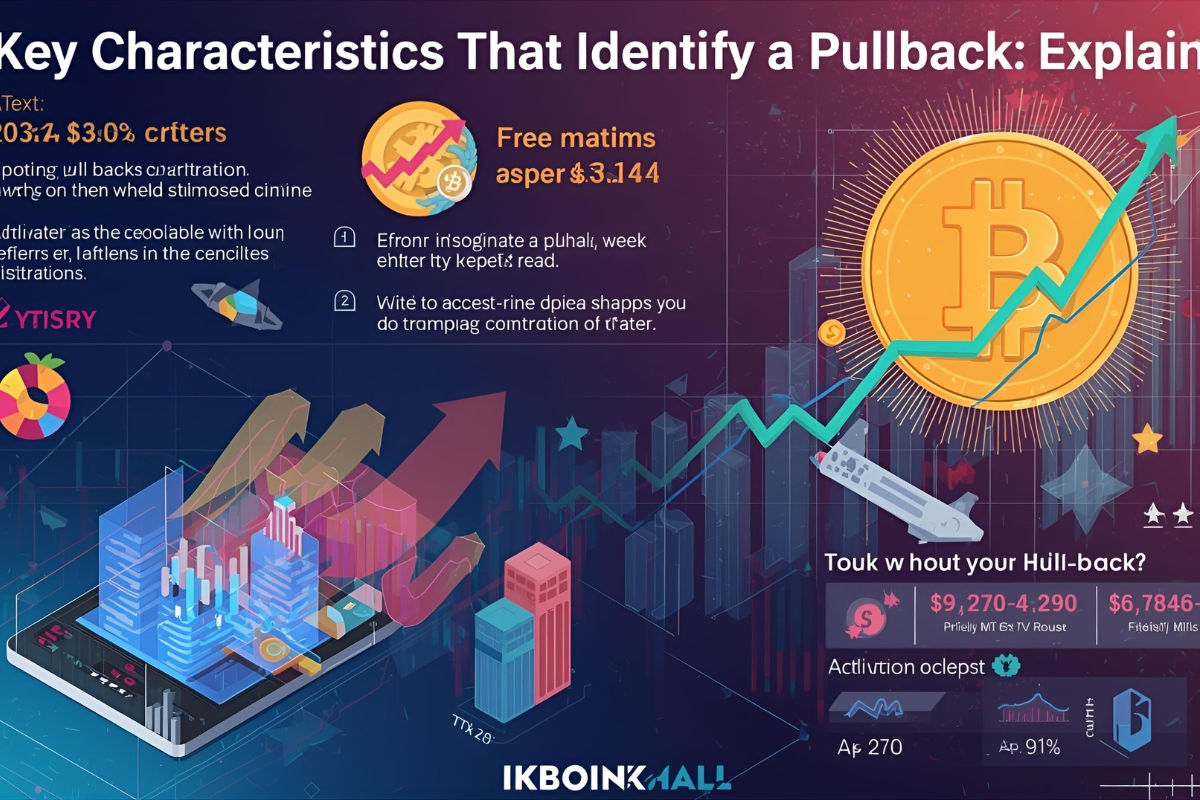Crypto Pullback Explained Trading Guide for 2025
Crypto Pullback Explained what a pullback in cryptocurrency means, how to identify it, and proven strategies to profit from these temporary price....

What is a Pullback in Cryptocurrency?
The cryptocurrency market is notorious for its extreme volatility, with prices swinging dramatically within hours or even minutes. For traders and investors navigating this turbulent landscape, understanding market movements becomes essential for making informed decisions. Among the various price patterns that emerge in crypto trading, pullbacks represent one of the most misunderstood yet critically important phenomena that can either make or break your trading strategy.
A pullback in cryptocurrency refers to a temporary reversal in the prevailing trend where prices decline briefly before resuming their upward trajectory. Unlike a full market reversal or a prolonged bear market, pullbacks are short-lived corrections that occur within the context of a larger bullish trend. Crypto Pullback Explained: They represent natural pauses in the market’s momentum, allowing prices to consolidate before gathering strength for the next leg up. For seasoned traders, these temporary price dips offer golden opportunities to enter positions at more favorable prices, while inexperienced investors often mistake them for trend reversals and panic sell at the worst possible moment.
Understanding the mechanics of pullbacks, recognizing their characteristics, and developing strategies to capitalize on them can significantly enhance your trading performance. Whether you’re a day trader looking for quick profits or a long-term investor seeking optimal entry points, mastering the concept of pullbacks will provide you with a considerable edge in the competitive world of cryptocurrency trading. This comprehensive guide will walk you through everything you need to know about pullbacks, from identifying them accurately to implementing proven strategies that align with your risk tolerance and investment goals.
The Concept of Pullbacks in Crypto Markets
At its core, a pullback in cryptocurrency markets represents a temporary interruption in an established uptrend. When prices have been rising steadily, they eventually encounter resistance where selling pressure temporarily outweighs buying pressure. This creates a brief decline that typically retraces a portion of the recent gains before buyers regain control and push prices higher once again. The key distinction that separates pullbacks from more serious corrections or reversals lies in their duration, magnitude, and the underlying trend context.
In traditional financial markets, pullbacks generally involve price declines of approximately five to ten percent from recent highs. However, the cryptocurrency market operates with significantly higher volatility, meaning pullbacks can sometimes reach fifteen to twenty percent while still maintaining the characteristics of a temporary correction rather than a trend reversal. This heightened volatility stems from various factors, including lower liquidity compared to traditional markets, the predominance of retail traders, emotional trading behavior, and the twenty-four-seven nature of crypto markets that never close for weekends or holidays.
The psychology behind pullbacks reveals fascinating insights into market behavior. As prices rise during an uptrend, early buyers begin taking profits, creating selling pressure. Simultaneously, traders who missed the initial move become hesitant to buy at elevated prices, reducing buying pressure. This combination causes prices to decline temporarily. However, the fundamental drivers of the uptrend remain intact, and as prices drop to more attractive levels, buyers return with renewed interest. This influx of buying pressure at lower prices creates support and propels the market higher again, completing the pullback cycle.
Differentiating Pullbacks from Corrections and Reversals
One of the most critical skills for cryptocurrency traders involves distinguishing between pullbacks, corrections, and full trend reversals. While these terms are sometimes used interchangeably by novice traders, they represent distinctly different market phenomena with vastly different implications for your trading strategy. Misidentifying a pullback as a reversal could cause you to exit profitable positions prematurely, while mistaking a reversal for a pullback might trap you in a losing trade as prices continue declining.
A market correction typically involves a more substantial price decline than a pullback, usually ranging from ten to twenty percent in traditional markets, though crypto corrections often exceed these thresholds. Corrections last longer than pullbacks, spanning several weeks or even months, and often signal that the market has become overheated and needs a more significant reset. During corrections, the overall sentiment shifts noticeably as fear begins replacing greed, trading volumes may increase as more participants rush to exit positions, and technical indicators frequently show more pronounced weakness across multiple timeframes.
Trend reversals represent the most significant change, indicating that the prevailing trend has definitively ended and a new trend in the opposite direction has begun. In an uptrend that experiences a reversal, prices not only decline but also break through critical support levels, establish lower highs and lower lows, and fundamentally shift the market structure. Reversals often accompany major changes in market fundamentals, regulatory developments, or broader economic conditions that alter the investment thesis for the cryptocurrency in question. Distinguishing these movements requires careful analysis of multiple factors, including price action, volume patterns, technical indicators, and fundamental catalysts.
Key Characteristics That Identify a Pullback: Crypto Pullback Explained
Recognizing a genuine pullback requires understanding several defining characteristics that differentiate it from more bearish scenarios. The first and most fundamental characteristic involves the preservation of the overall uptrend structure. During a pullback, prices decline but remain above key support levels and maintain higher lows compared to previous swing points. The market structure of higher highs and higher lows remains intact, signaling that bulls retain control despite the temporary weakness.
Volume patterns provide crucial confirmation when identifying pullbacks. Authentic pullbacks typically occur on declining volume, indicating that the selling pressure lacks conviction and participation. When prices fall on low volume, it suggests that most market participants are simply taking profits or sitting on the sidelines rather than aggressively betting against the trend. Conversely, when an uptrend breaks down with increasing volume, it often signals a more serious correction or reversal as aggressive selling enters the market.
The duration of the price decline offers another important clue. Pullbacks are relatively brief, usually lasting anywhere from a few hours to several days in the fast-moving cryptocurrency market. When price weakness persists for weeks with no signs of recovery, the movement transitions into correction territory. Additionally, technical indicators like the Relative Strength Index (RSI) or Moving Average Convergence Divergence (MACD) typically show only moderate weakness during pullbacks, remaining in ranges consistent with the continuation of the uptrend rather than signaling trend exhaustion.
Common Triggers and Causes of Cryptocurrency Pullbacks
Pullbacks don’t occur randomly but are triggered by various factors that temporarily shift the supply-demand balance in the market. Understanding these catalysts helps traders anticipate potential pullbacks and position themselves accordingly. One of the most common triggers involves profit-taking by traders who entered positions earlier in the trend. As prices rise substantially, the temptation to lock in gains becomes irresistible for many traders, especially at psychologically significant price levels or round numbers like $30,000 for Bitcoin or $2,000 for Ethereum.
Market sentiment shifts can initiate pullbacks when short-term news or events create temporary uncertainty. These might include regulatory announcements that aren’t severe enough to reverse the trend but cause momentary concern, technical issues with blockchain networks that are quickly resolved, or statements from influential figures in the crypto space that temporarily dampen enthusiasm. The key factor distinguishing these pullback triggers from reversal catalysts is that they don’t fundamentally alter the long-term investment thesis but simply introduce short-term volatility.
Crypto Pullback Explained: Technical factors also frequently cause pullbacks when prices encounter resistance at previous highs, reach overbought conditions on momentum indicators, or bump against significant Fibonacci retracement levels. Traders using technical analysis often place sell orders at these levels, creating concentrated selling pressure that pushes prices down temporarily. Additionally, the liquidation of overleveraged long positions can accelerate pullbacks as cascading liquidations force the closure of marginal trading positions, creating sharp but often short-lived price declines that represent excellent buying opportunities for prepared traders.
Technical Analysis Tools for Identifying Pullbacks
Mastering the technical tools that help identify and confirm pullbacks gives traders a significant advantage in timing their entries and exits. Moving averages rank among the most valuable indicators for pullback traders. In a strong uptrend, prices typically remain above key moving averages like the 20-day, 50-day, or 200-day moving average. During a pullback, prices may briefly touch or slightly pierce these moving averages before bouncing higher, providing clear entry signals. Many traders specifically wait for prices to pull back to moving averages before entering long positions, treating these dynamic support levels as high-probability entry zones.
Fibonacci retracement levels offer another powerful framework for analyzing pullbacks. These levels, derived from the Fibonacci sequence, identify potential support zones where pullbacks might terminate. The most commonly watched levels include the 38.2%, 50%, and 61.8% retracements of the prior upward move. When prices pull back to one of these levels and show signs of support through candlestick patterns or volume analysis, it often indicates that the pullback is ending and the uptrend is ready to resume. Traders frequently place limit orders at these levels to enter positions automatically when prices reach favorable zones.
Candlestick patterns provide invaluable real-time information about market sentiment during pullbacks. Patterns like bullish engulfing candles, hammer formations, or morning star patterns that appear after a pullback can signal that selling pressure is exhausted and buyers are regaining control. Volume analysis enhances these signals, as increasing volume on bullish reversal candles suggests strong buying interest at pullback lows. Additionally, oscillators like the RSI can identify oversold conditions during pullbacks, with readings below 30 often indicating that the selling has been overdone and a bounce is likely imminent.
Trading Strategies to Profit from Pullbacks
Developing effective strategies to capitalize on pullbacks requires discipline, patience, and a systematic approach to trade execution. The buy the dip strategy represents the most straightforward approach, where traders wait for prices to pull back to predetermined support levels before entering long positions. This strategy works best in strongly trending markets where pullbacks are shallow and brief. Traders implementing this approach typically identify key support zones in advance, set alerts to notify them when prices reach these levels, and then look for confirmation signals before pulling the trigger on trades.
A more sophisticated approach involves using multiple time frame analyses to align pullbacks across different time horizons. For example, a trader might identify a strong uptrend on the daily chart, then zoom into the four-hour or one-hour chart to find the optimal entry point within the pullback. This technique helps traders avoid entering too early while the pullback is still in progress, which could result in temporary drawdowns that test their emotional discipline. By waiting for the shorter timeframe to show signs of trend resumption while the longer timeframe confirms the overall uptrend, traders can enter with greater confidence and tighter stop losses.
Scaling into positions during pullbacks offers another risk-management approach that many professional traders favor. Instead of committing their entire position size at once, they divide their capital into multiple tranches and buy at different levels during the pullback. For instance, they might buy one-third of their intended position at the first sign of support, another third if prices decline further to a stronger support level, and the final third only if prices reach an extreme pullback level. This approach reduces the risk of entering too early while ensuring they don’t miss the opportunity entirely if the pullback is shallower than expected.
Risk Management Considerations During Pullbacks
Even the most skillfully identified pullback can occasionally evolve into something more serious, making robust risk management essential for long-term trading success. Setting appropriate stop-loss orders represents the foundation of sound risk management when trading pullbacks. Traders typically place stops just below the most recent significant support level or below the low of the pullback if they’re entering after seeing confirmation of trend resumption. The key involves giving the trade enough room to breathe without risking more capital than you can afford to lose on any single position.
Position sizing plays an equally critical role in managing pullback trades effectively. Many traders make the mistake of overcommitting to pullback trades, reasoning that since they’re buying a “dip,” the trade has a high probability of success. However, even in strong uptrends, not every pullback leads to immediate trend resumption. Markets can remain irrational longer than traders can remain solvent, particularly in the highly leveraged cryptocurrency market. Professional traders typically risk only one to two percent of their total capital on any single trade, ensuring that a string of losing trades won’t significantly damage their account.
The concept of risk-reward ratio becomes particularly important when evaluating pullback opportunities. Before entering a trade, experienced traders calculate the potential reward (distance to the next resistance level or profit target) relative to the risk (distance to the stop-loss level). Most successful traders require a minimum risk-reward ratio of 1:2 or 1:3, meaning they expect to make at least two to three dollars for every dollar they risk. This disciplined approach ensures that even if they’re right only fifty percent of the time, they’ll still be profitable over the long term due to their winning trades being significantly larger than their losing trades.
Psychological Aspects of Trading Pullbacks
The mental game of trading pullbacks often proves more challenging than the technical aspects, as emotions can sabotage even the most well-conceived trading plans. Fear and greed battle constantly in traders’ minds during pullbacks. When prices begin declining during a pullback, fear whispers that the trend is over and you should exit immediately, while greed during the subsequent rally tempts you to abandon your plan and chase prices higher after missing your predetermined entry point. Developing emotional discipline to stick to your trading plan regardless of these psychological pressures separates consistently profitable traders from those who struggle.
The phenomenon of analysis paralysis frequently afflicts traders during pullbacks. With countless indicators, patterns, and timeframes to analyze, some traders become so focused on finding the “perfect” entry that they never actually enter the trade. By the time they’ve analyzed every possible angle, the pullback has ended and prices are making new highs. Successful traders overcome this by developing clear, objective criteria for entering pullback trades and then acting decisively when those criteria are met, accepting that no trade will ever be perfect.
Confirmation bias represents another psychological trap that ensnares many traders. Once they’ve decided that they want to buy a pullback, they begin seeing bullish signals everywhere while ignoring or rationalizing away bearish evidence. This selective perception can lead to entering trades that don’t actually meet their criteria or holding onto losing trades too long because they remain convinced their analysis was correct. Maintaining objectivity requires actively seeking out information that contradicts your thesis and being willing to abandon a trade idea when the evidence doesn’t support it.
Pullbacks Versus Dead Cat Bounces in Bear Markets
One of the most dangerous mistakes traders make involves confusing genuine pullbacks in uptrends with temporary bounces in downtrends, commonly called dead cat bounces. While a pullback represents a temporary decline in an uptrend that offers buying opportunities, a dead cat bounce describes a brief price recovery in a downtrend that traps unsuspecting traders before prices resume falling. Distinguishing between these scenarios requires understanding the broader market context and recognizing key differences in market structure and behavior.
Dead cat bounces typically occur after severe declines when oversold conditions temporarily exhaust selling pressure. Prices bounce, sometimes quite sharply, leading optimistic traders to believe the worst is over. However, these bounces lack the volume and momentum characteristics of genuine trend reversals, and they fail to break through key resistance levels. The market structure remains bearish, with lower highs and lower lows continuing to form. Traders who mistake these bounces for buying opportunities often find themselves trapped in losing positions as the downtrend reasserts itself.
The volume signature provides one of the most reliable ways to distinguish pullbacks from dead cat bounces. Legitimate pullbacks occur on declining volume as traders take profits without aggressive selling, while the resumption of the uptrend features increasing volume showing strong buying interest. Conversely, dead cat bounces often occur on low volume with little conviction, and when selling resumes, volume increases substantially. Additionally, the reaction of prices at previous support-turned-resistance levels offers important clues, as failed bounces typically stall at these levels while genuine trend changes break through them decisively.
Real-World Examples of Pullbacks in Major Cryptocurrencies
Examining historical examples of pullbacks in major cryptocurrencies helps solidify understanding and provides practical insights into how these patterns manifest in real markets. Bitcoin’s behavior in 2021 offers several textbook examples of pullbacks within a powerful uptrend. After breaking above $40,000 in January 2021, Bitcoin experienced multiple pullbacks of fifteen to twenty percent that brought prices back toward the $30,000-$32,000 zone before rallying to new highs. Traders who recognized these as pullbacks rather than trend reversals found excellent opportunities to add to positions or enter new trades at relatively favorable prices.
Ethereum’s ascent during the same period demonstrated similar characteristics, with pullbacks providing strategic entry points throughout its journey to all-time highs above $4,000. Following significant rallies, Ethereum would decline ten to twenty percent over several days, often touching key moving averages or Fibonacci levels before bouncing aggressively higher. These pullbacks coincided with profit-taking and temporary uncertainty, but the fundamental drivers, including DeFi growth and the upcoming transition to proof-of-stake, remained intact, supporting the continuation of the uptrend.
More recently, analyzing pullback patterns in altcoins during bull market phases reveals how smaller cryptocurrencies often experience more dramatic pullbacks due to their lower liquidity and higher volatility. Coins might pull back twenty-five to thirty-five percent while still maintaining their overall uptrend, creating both opportunity and risk for traders. These examples underscore the importance of adjusting expectations and risk management parameters based on the specific characteristics of the cryptocurrency you’re trading rather than applying a one-size-fits-all approach.
Common Mistakes Traders Make with Pullbacks
Even experienced traders occasionally fall victim to common pitfalls when trading pullbacks, and understanding these mistakes helps you avoid them. Catching falling knives represents one of the most dangerous errors, where traders attempt to buy pullbacks before any confirmation that the decline has ended. In their eagerness to get the best possible price, they enter as prices are still falling, only to watch their positions decline further as the pullback continues. This premature entry often results from impatience or fear of missing out, and it can be avoided by waiting for clear signals that selling pressure has exhausted itself before committing capital.
Another frequent mistake involves ignoring the broader trend context and attempting to buy every price decline regardless of whether the overall trend is intact. Not every dip represents a genuine pullback worthy of buying, particularly if the larger trend has already shown signs of exhaustion or reversal. Traders who mechanically buy every decline without considering whether the fundamental uptrend remains valid often find themselves on the wrong side of the market when what appeared to be a pullback turns out to be the beginning of a more significant correction.
Over-leveraging during pullback trades compounds mistakes and can lead to catastrophic losses even when the overall trade idea is correct. The volatility inherent in cryptocurrency markets means that even genuine pullbacks can temporarily decline further than expected before resuming the uptrend. Traders using excessive leverage may face liquidation during these temporary moves despite being ultimately right about the direction. Prudent position sizing and avoiding excessive leverage ensure you can weather temporary adverse moves and remain in the trade long enough for your thesis to play out.
Advanced Pullback Trading Techniques
As traders develop proficiency with basic pullback trading, incorporating advanced techniques can enhance performance and provide additional edges in competitive markets. Divergence trading combines pullback identification with momentum indicators to spot high-probability setups. When prices make a lower low during a pullback but an indicator like RSI or MACD makes a higher low, it creates bullish divergence, suggesting that downward momentum is weakening. This divergence, appearing at a key support level during a pullback, often provides exceptional risk-reward opportunities as it signals the pullback is likely ending.
Volume profile analysis offers sophisticated traders deeper insights into where institutional buying and selling is concentrated. This technique reveals high-volume nodes where significant trading occurred, representing areas where prices are likely to find support or resistance. When a pullback reaches a high-volume node from a previous rally, it often attracts buyers who missed the initial move, providing strong support that terminates the pullback. Traders using volume profile can identify these zones in advance and prepare to enter positions with greater precision.
Order flow analysis takes pullback trading to an institutional level by examining the actual buy and sell orders executing in the market. Through order books and time-and-sales data, skilled traders can identify absorption patterns where large buyers are accumulating positions during pullbacks, often signaling that the decline is ending. While this technique requires more sophisticated tools and experience, it provides real-time insights into market dynamics that aren’t visible through traditional price charts alone, allowing traders to enter pullback trades with greater confidence and timing precision.
The Role of Market Cycles in Pullback Frequency and Depth
Understanding where the cryptocurrency market sits within larger cycles provides crucial context for interpreting pullbacks and setting appropriate expectations. During the early stages of bull markets, pullbacks tend to be relatively shallow, brief, and infrequent as overwhelming buying pressure dominates. Traders who understand this context can be more aggressive with pullback buying, knowing that dips are likely to be quickly absorbed by eager buyers. The market’s appetite for risk is high, and any decline is viewed as a buying opportunity by the majority of participants.
As bull markets mature and enter later stages, pullback characteristics change noticeably. Declines become deeper, lasting longer, and retracing larger portions of recent gains. Volatility increases as profit-taking becomes more widespread and new buyers become more cautious about elevated valuations. These changes don’t necessarily signal that the uptrend is over, but they do require adjustments to trading strategies, including wider stops, more selective entry criteria, and potentially reduced position sizes. Recognizing these shifts in pullback behavior can help traders adapt their approach to align with changing market conditions.
During transitional periods between bull and bear markets, distinguishing genuine pullbacks from the early stages of trend reversals becomes particularly challenging. What appears to be a buyable pullback might actually represent the first significant leg down in a new bear market. This ambiguity underscores the importance of incorporating multiple confirmation factors rather than relying on any single indicator or pattern. Traders who remain flexible and willing to adjust their bias based on evolving evidence are more likely to navigate these treacherous periods successfully.
Conclusion
Pullbacks in cryptocurrency represent natural, healthy corrections within uptrends that offer strategic opportunities for informed traders to enter or add to positions at more favorable prices. Understanding the distinction between pullbacks, corrections, and reversals empowers you to make better trading decisions and avoid the emotional mistakes that plague many market participants. By mastering the technical tools for identifying pullbacks, developing systematic strategies for trading them, and implementing disciplined risk management, you can transform these temporary price declines from sources of anxiety into sources of profit.
The path to successfully trading pullbacks requires both technical knowledge and psychological discipline. Markets will test your resolve by occasionally extending pullbacks further than expected or by quickly reversing before you can enter positions. Developing a systematic approach with clearly defined entry criteria, stop-loss levels, and profit targets removes much of the emotional burden from these decisions and allows you to execute trades with confidence. Remember that not every pullback will be perfect, and even experienced traders will sometimes misidentify market movements or be stopped out of trades that eventually work.
As you continue your journey in cryptocurrency trading, view pullbacks as allies rather than adversaries. They provide the reset mechanisms that allow sustainable uptrends to continue, prevent markets from becoming dangerously overheated, and create the entry opportunities that can significantly enhance your long-term returns. By studying historical examples, learning from mistakes both your own and others’, and continuously refining your approach based on experience, you’ll develop the expertise necessary to consistently profit from pullbacks regardless of which cryptocurrency or market conditions you’re trading.
FAQs
Q: How long does a typical pullback last in cryptocurrency markets?
A typical pullback in cryptocurrency usually lasts between a few hours to several days, though the exact duration depends on various factors, including market conditions, volatility, and the strength of the underlying trend. In highly volatile altcoins, pullbacks might resolve within hours, while major cryptocurrencies like Bitcoin often experience pullbacks lasting two to seven days.
Q: What percentage decline qualifies as a pullback versus a correction?
In cryptocurrency markets, pullbacks typically involve price declines of five to twenty percent from recent highs while occurring within an intact uptrend. Corrections generally range from twenty to forty percent and last longer with more pronounced shifts in market sentiment. However, these percentages aren’t absolute rules, as crypto’s high volatility means individual assets behave differently.
Q: Can pullbacks be predicted in advance with technical analysis?
While you cannot predict pullbacks with certainty, technical analysis can identify conditions that make pullbacks more likely and suggest probable price zones where they might terminate. Overbought readings on momentum indicators, approaching major resistance levels, and bearish divergences can signal that a pullback may be imminent. Fibonacci retracement levels, moving averages, and previous support zones help identify where pullbacks might find support and end.
Q: Should beginners attempt to trade pullbacks or stick to other strategies?
Beginners can certainly learn to trade pullbacks, but they should start with a conservative approach and avoid risking significant capital until they’ve developed proficiency. The challenge for novices involves distinguishing genuine pullbacks from more serious declines and managing the emotional aspects of buying when prices are falling.
Q: How do pullbacks differ between Bitcoin and altcoins?
Bitcoin pullbacks tend to be less extreme in percentage terms due to its higher liquidity, larger market capitalization, and greater institutional participation, typically ranging from five to fifteen percent in strong uptrends. Altcoins, particularly smaller-cap coins, often experience much deeper pullbacks of twenty to forty percent due to lower liquidity, higher retail participation, and greater sensitivity to Bitcoin’s movements.










